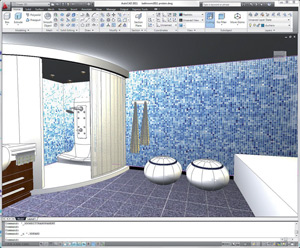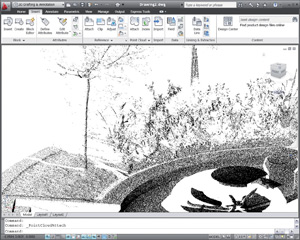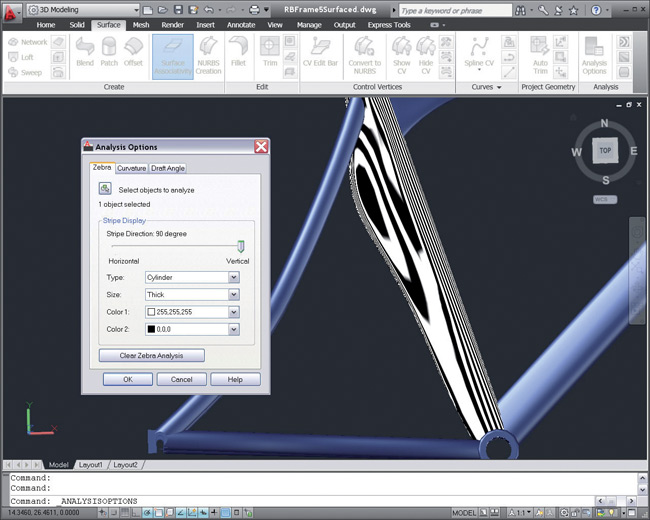Every Spring Autodesk produces its annual updates to its now vast range of applications. Spanning AEC, Manufacturing and Media and Entertainment, the products should provide something for everyone. Martyn Day went to San Francisco to hear what is new.
At one time, Autodesk was considered to be a one-product company. While it was the global leader in 2D design systems, it only had AutoCAD and that was it. Since then the company has continued to grow, reaching a turnover of $2 billion pre-bank initiated global meltdown and its product portfolio has broadened greatly beyond its historic 2D drafting realm.
That is not to say AutoCAD is not important, it is still a global industry standard and its little brother, AutoCAD LT, still sells enormously well. This means that on global launch day, despite having very popular 3D design systems such as Inventor and Revit, AutoCAD still makes headline news. In fact, to describe AutoCAD as a 2D system is disingenuous, as over the past three years substantial 3D capabilities have been added, making AutoCAD a very capable, generic 3D modeller, compatible with Autodesk’s other 3D systems.
The 2011 product launch was held in downtown San Francisco, in Autodesk’s impressive gallery, where it displays products that its customers have made, featuring everything from Lego to a complete Ford Mustang, which required a crane and for one of the gallery windows to be temporarily taken out. Autodesk chief executive Carl Bass and senior vice-president of Platform Solutions and Emerging Business, Amar Hanspal, were master of ceremonies for the event and simultaneous web broadcast. AutoCAD resides in the Platform group and so sat central stage, before demonstrations of Inventor 2011 and the Revit Suite of products.
AutoCAD new features

The first piece of good news is that DWG is staying the same, so no file format hassle with this upgrade. The second piece of news is slightly confusing, as in this release AutoCAD clearly becomes a fully featured 3D modelling tool, featuring very powerful surfacing commands for Non-Uniform Rational B-Splines (NURBS) and procedural surfaces. Last year’s parametrics have been enhanced, such as the ability to infer constraints as well as driving some underlying 3D geometry. Another great addition has been the inclusion of a very capable Point Cloud engine, allowing highly accurate laser scans of products or buildings to be brought into the native AutoCAD environment. Typically tools that do this well cost thousands of pounds. This will be useful for reverse engineering, quality inspection and building/road design.
Of course, there was the usual array of 2D enhancements to appeal to the core AutoCAD community. Transparency is now an object property and can be used in fills and gradients, hatch supports enhanced splines and there are also some slick new visual styles for the display. The new materials browser is standard across all key design products. However, as usual AutoCAD LT gets only the relevant subset of 2D updates.
Under the bonnet
One of the lesser-known stories behind this batch of releases is the engineering work that has gone on behind the scenes. Autodesk has had two long-held objectives: to get the products to share data better and to standardise the software components. To this aim the 2011 products represent a significant delivery on longstanding development goals.
Internally known as the AIRMAX initiative (AutoCAD, Inventor, Revit and MAX), these 2011 products now share the same graphics engine. While this provides a great boost in performance for products such as Revit, the standardisation also means that materials have the same look and feel for predictable results. The inclusion of a standard material library with each application means that projects will look exactly the same in all products, producing fewer surprises when collaborating or mixing and matching Autodesk applications.
This also reduces the development and quality effort for Autodesk’s development teams as the portfolio of products continues to swell. It will be useful should Autodesk acquire new products in the future.
Subscription

As we all know these are challenging economic times and in the CAD market every vendor has seen sales drop quite dramatically. That makes Autodesk’s already substantial subscription business, all the more important to maintain. Traditionally, Autodesk has never really offered much beyond the next release for the subscription fee but in recent years, additional functionality has been delivered mid-cycle across its product range. That appears to be the future direction, where Autodesk will offer more ‘perks’ to subscribing customers.
Of course it helps to know if you are on subscription that you have the right to download the goodies. It is amazing but it seems many users not aware of what they could have access to.
Channel changes
Accredited resellers of Autodesk products typically only sell products in vertical markets for which they are authorised, and even then not all the products that maybe available. So an AEC reseller may have Revit Architecture but not Civil 3D.
To sell and support products, Autodesk has, in the past, made resellers apply for each and every product. Under new regulations, the resellers can sell all the products from each of its verticals. This means that customers need not have multiple resellers to get their specific product suite. However, the rules are no so relaxed that resellers can easily sell both AEC and Manufacturing products; they are a rarity. Hopefully this will change in future.
Conclusion
AutoCAD 2011 is the basis for many vertical products; AutoCAD Architecture, AutoCAD Electrical, Civil 3D and Electrical, to name but a few, and all see these benefits plus vertical enhancements. This new vanilla version should change the perception that AutoCAD is a 2D system, with years of development and now powerful surfacing, an in-depth library and great on-board rendering, it has plenty of potential to be a strong product or form modelling tool. Autodesk appears to be pitching it against McNeel and Associates’ Rhino, which also has a loyal and trusted following.
This AutoCAD release will elate existing 3D AutoCAD customers and do more to potentially convert existing 2D users should they be interested enough to investigate beyond their usual commands. The new point cloud engine will also expand the application’s usefulness for renovation, retrofit and reverse engineering.
{mospagebreak}
Key highlights
AutoCAD Architecture 2011 Once called Architectural Desktop (ADT), AutoCAD Architecture and AutoCAD MEP are still two very popular design systems. The main advantage of these applications is that they are based on AutoCAD and have an advanced suite of specific capabilities for architects and services engineers.
The new versions include the ability to constrain dimensions and geometry (based on the constraints engine added to AutoCAD last release). For architects, and aimed at renovation/retrofit, a new demolished mode makes it easy to see edits to the existing state, wall clean ups have also improved. MEP can route multiple parallel conduits, proper elbow generation and automatic male/female connections to pipe fittings.
Functionality added in the last subscription extension has also been included, namely the enhanced custom grid, the custom column tool and the ability to place multiple equally spaced openings in an object.
Revit Architecture 2011 With over 350,000 seats now sold, it is pretty safe to say Building Information Modelling has well and truly taking off. That said, there is still plenty to add and each year it seems that the Revit suite (Architecture, Structure and MEP) seem to get the lion’s share of the hot new features.
Revit Architecture has had additional enhancements to its conceptual design tools, making it easier to create complex forms, edit them, see and rationalise the surfaces. Any changes to the conceptual model can also link through to the actual building model. The User Interface (UI) has been improved again but without too much of a radical change, providing faster access to tools. As was previously seen on Autodesk Labs, sun path simulation has been enhanced, as have better links to Green Building Studio. The rendering system has been improved and there are new display view styles.
Revit Structure 2011 Structural engineers can rejoice as there have been a good number of core enhancements to Revit, such as the inclusion of sloped and curved beams and columns, custom truss designs from sketches, better support for rebar and the display of the physical loads on the elements. The growing API has been used to assist in the creation of wood and steel frames and even bridge and road design.
Revit MEP 2011 Probably the weakest of the Revit Suite, in terms of capabilities, and it certainly struggled with UK British Standards until a subscription delivery last summer, the new version adds some serious muscle bringing it in line with the capabilities of its companion products. With a much bigger library of parts, new in this release are conduits, cable trays and panel boards, with a good deal for those wanting to include electrical circuits and some very clever tools for keeping track of lighting fixtures generated by architects.
Navisworks 2011 This is such a great product with so many uses, Navisworks 2011 has mainly had a big facelift and now comes with the ubiquitous ribbon interface and the navigation tools that feature throughout Autodesk’s product range. Navisworks is designed to be the single truth between architectural, structural and MEP models, where clash detection and site simulation can take place (4D). To aid the 4D element, Navisworks now plays friendly with Primavera’s scheduling capabilities and happily supports Gantt charts.
Green Building Studio and Ecotect Analysis 2011 GBS was previously a benefit of being on subscription for Ecotect Analysis, but is now available to all subscribers, including Revit MEP and Revit Architecture. This makes a lot of sense, as errors made at the beginning tend to be carried forward throughout the rest of the project. Ecotect has had a similar user interface enhancement.
The need to evaluate buildings undergoing retrofit is driving Autodesk Rapid Energy Modelling. While point cloud is now included in AutoCAD, Revit does not have this capability yet. Using AutoCAD, Revit Architecture and products like Autodesk Image Modeler, users can capture and create a building then import it into Ecotect to analyse the performance, and then assess any subsequent improvement.
As a side note, Autodesk is planning to add sensors to its headquarters so it can calibrate its Ecotect findings on its retrofit designs versus reality.
AutoCAD Civil 3D and Map 2011 Civil 3D is a product with real potential. While it is based on AutoCAD, it is a major object ARX customisation of the core code, generating 3D models and 2D.
With the size of projects, a new 64 bit version is more than welcome and obviously benefits from the faster graphics and point cloud support provided by the base AutoCAD. Alignments and offset alignments, curves, roundabouts, super-elevation view/edit have all been improved.
The new drive command lets users drive through a rough rendered version to consider the design. Line of sight tools have been enhanced to allow the checking of minimum passing and stopping sight distance requirements. The ‘zone of visual influence’ also gives a 360 degree view at any point. The ‘create section sheets’ is a wizard driven routine that automates the generation of layouts for plotting cross sections. And finally DGN interoperability has been improved to bring selected elements in as an AutoCAD underlay.
The latest version of Map has improved overlay capabilities too, enabling different kinds of data types to be imported and analysed, such as population, crime and accidents.
3ds Max Design 2011 This is the variant of 3ds Max for the design community. The latest version has a powerful collection of updates: the quicksilver hardware renderer, enhanced composite rendering to bring in live action, the new powerful slate material editor, and a big and common material library. In terms of interoperability, it now takes Google SketchUp V6 and 7 models and a non-destructive import of surfaces and solids using the FBX format between Max and Revit / Inventor. When combined with Autodesk Civil 3D and subscription, the forthcoming ‘Dynamite 3am’ technology, which Autodesk recently purchased, should make for an amazing suite of design and visualisation tools.






